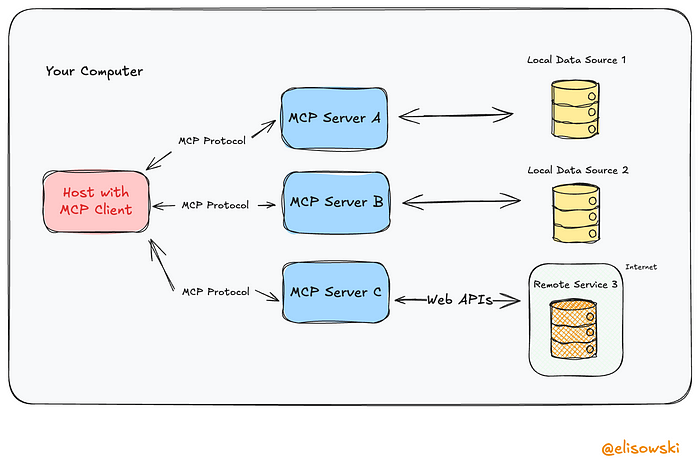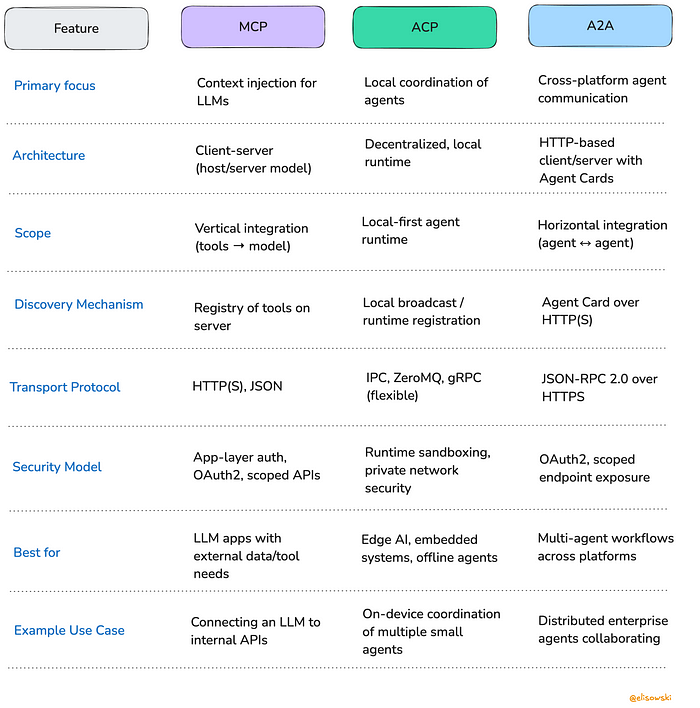
Introduction
- This report analyzes three emerging AI agent communication protocols that are shaping the future of AI systems integration: Model Context Protocol (MCP), Agent Communication Protocol (ACP), and Agent2Agent Protocol (A2A).
- These protocols represent different approaches to solving key challenges in AI agent interoperability, context management, and multi-agent coordination, with significant implications for AI engineers and system architects.
Part 1: Overview of AI Agent Protocols
The Emerging Standards Landscape
-
The field of AI agent communication is rapidly evolving with three major protocols emerging from different organizations:
- Model Context Protocol (MCP): Introduced by Anthropic
- Agent Communication Protocol (ACP): Proposed by BeeAI and IBM
- Agent2Agent Protocol (A2A): Developed by Google
-
Each protocol addresses a distinct aspect of the AI agent ecosystem:
- MCP focuses on providing structured context to language models
- ACP enables local-first agent coordination
- A2A facilitates cross-platform agent communication

Part 2: Model Context Protocol (MCP)
Core Functionalities
- Contextual Data Injection: MCP enables external resources (files, database rows, API responses) to be integrated directly into prompt or working memory through a standardized interface.
- Function Routing & Invocation: Allows models to dynamically call tools by registering capabilities like
searchCustomerDataorgenerateReportthat can be invoked on demand. - Prompt Orchestration: Facilitates modular, on-the-fly prompt construction for smarter context management with fewer tokens and better outputs.
Implementation Characteristics
- Operates over HTTP(S) with JSON-based capability descriptors
- Designed to be model-agnostic, compatible with any LLM with a compatible runtime
- Works with enterprise authentication standards (OAuth2, mTLS)
Engineering Use Cases
- LLM integrations for internal APIs: Secure access to structured business data without exposing raw endpoints
- Enterprise agents: Equipping autonomous agents with runtime context from tools like Salesforce, SAP, or internal knowledge bases
- Dynamic prompt construction: Tailoring prompts based on user session, system state, or task pipeline logic
Part 3: Agent Communication Protocol (ACP)
Protocol Design & Architecture
- ACP defines a decentralized agent environment where:
- Agents advertise their identity, capabilities, and state through a local broadcast/discovery layer
- Communication occurs through event-driven messaging via local bus or IPC systems
- Optional runtime controllers can orchestrate behavior, aggregate telemetry, and enforce policies
Implementation Characteristics
- Designed specifically for low-latency environments (robotics, offline edge AI)
- Can be implemented over gRPC, ZeroMQ, or custom runtime buses
- Emphasizes local sovereignty with no cloud dependency or external service registration
- Supports capability typing and semantic descriptors for automated task routing
Engineering Use Cases
- Multi-agent orchestration on edge devices: Applications in drones, IoT clusters, or robotic fleets
- Local-first LLM systems: Coordination of model invocations, sensor inputs, and action execution
- Autonomous runtime environments: Enabling agent coordination without centralized cloud infrastructure
Part 4: Agent2Agent Protocol (A2A)
Protocol Overview
- A2A defines an HTTP-based communication model where agents function as interoperable services
- Each agent exposes an "Agent Card" - a machine-readable JSON descriptor detailing identity, capabilities, endpoints, and authentication requirements
- Currently specifies JSON-RPC 2.0 over HTTPS as its core interaction mechanism

Core Components
- Agent Cards: JSON documents describing capabilities, endpoints, message types, auth methods, and runtime metadata
- A2A Client/Server Interface: Agents can function as clients, servers, or both
- Message & Artifact Exchange: Support for multipart tasks, streaming output, and persistent artifacts
- User Experience Negotiation: Adaptation of message format and visualization to match downstream capabilities
Security Architecture
- OAuth 2.0 and API key-based authorization
- Capability-scoped endpoints exposing only required functions
- Support for "opaque" mode operation that hides internal logic while exposing callable services
Engineering Use Cases
- Cross-platform agent ecosystems: Secure interoperation between agents from different teams or vendors
- Distributed agent orchestration: Cloud-native AI environments (Vertex AI, LangChain, HuggingFace Agents)
- Multi-agent collaboration frameworks: Enterprise AI workflows spanning multiple systems (CRM, HR, IT)
Part 5: Comparative Analysis and Integration Potential
Side-by-Side Comparison

Complementary Relationships
- MCP and A2A Integration: These protocols solve different parts of the agent AI ecosystem and can work together effectively:
- "MCP connects AI to tools"
- "A2A connects AI to other AI"

- ACP's Distinct Role: ACP takes a different approach focused on local-first coordination without cloud requirements, ideal for:
- Limited bandwidth or low-latency requirements
- Privacy-sensitive applications requiring offline operation
- Deployment in internet-restricted environments
Future Outlook
- Convergence Scenario: A unified agent platform where A2A handles inter-agent communication, MCP manages tool/data access, and ACP-style runtimes support edge or offline scenarios
- Fragmentation Risk: Different vendors pushing proprietary protocol variations, creating integration challenges similar to early web services
- Middle Ground: Open-source tools and middleware could abstract differences and provide unified APIs while handling translation between protocols
Conclusion
- The AI agent protocol landscape is still in early development but shows promising approaches to solving different aspects of agent interoperability.
- MCP, ACP, and A2A each address distinct needs in the AI ecosystem and could potentially complement each other in comprehensive agent architectures.
- The future effectiveness of these protocols will depend on standardization efforts, open-source implementations, and industry adoption patterns.
- AI engineers should understand these protocols to make informed architectural decisions when designing multi-agent systems, considering factors like deployment environment, latency requirements, and integration needs.
Related Articles
- Understanding A2A Protocol - A detailed guide to the fundamentals of the A2A protocol
- A2A vs MCP: A Comprehensive Comparison - An in-depth comparison between A2A and MCP protocols
- Python A2A Tutorial with Source Code - Hands-on implementation guide for A2A protocol in Python
- A2A Sample Methods and JSON Responses - Reference guide for A2A protocol methods and response formats
Go A2A